#mc 7019
Text
It hasn’t been the central topic yet until this week, but we have talked about the importance of data in various classes this semester. The first reading from Styrcharz and Segijin talked about dataveillance and how important it has become in today’s digital world. I enjoyed that these two proposed a framework built around dataveillance effects with advertising because that’s really been the main central topic our class has talked about this semester when data has come up in conversation. I’d say I understand more about it now compared to the beginning of the semester, but there’s still so many questions I have about it all. The one proposal I agreed with the two authors about with this topic is the need for more research into the false belief side of it. There is still a lot of questions and false assumptions on this relatively young topic, so more research into it and developing stronger framework is a good way to fight it.
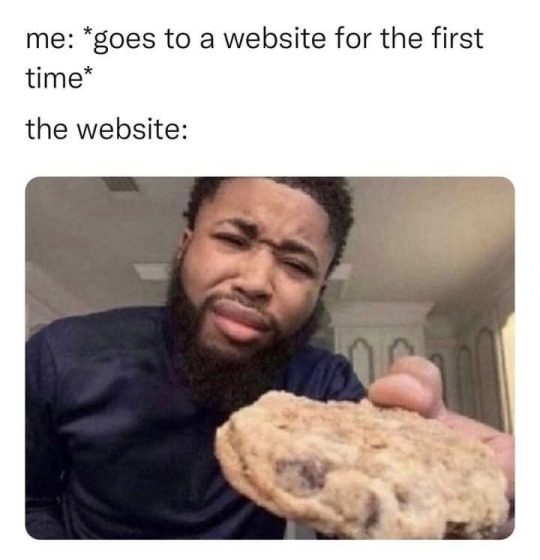
The other article that captured my attention was Stockmann’s on the role of the state with tech companies. I thought this piece was especially relevant right now given the current battle that TikTok and the United States are currently in. The article talks about different countries and how their models are different with handling these tech companies. I can’t speak for other countries as I don’t know enough about their models and what they strive to be, but from a United States standpoint, I do agree with some recent pushing against Meta and TikTok that there should be more transparency with the website’s data and how it is being used. If these websites can show the data and prove that they’re not using it in a negative way, they should be able to provide the service to Americans. While I agree with the government pushing for these answers, the problem is is that the people who were asking the questions usually make us look stupid once it finishes. I’m talking about both Meta’s hearing from a few years back and TikTok’s most recently. While there were some good questions, we really were left seeing “highlights” that were more “lowlights” and a lot of important data questions now answered. Perhaps the wrong people asked the questions, I don’t know.

0 notes
Text
MC 7019 Week 1 Blog
My first week’s reading materials really provided a new thought process on our overall online participation through social network sites, outlining the methodology and future research that needs to take place in communication to better analyze social media interactions and trends. The demographics and culture surrounding the web is a topic that I would like to dive into to learn more about inclusivity through social media and just how prevalent our media inequality gap is in the world. From the introduction of Web 2.0 up until our recent COVID virtual learning and working necessities, it appears that there has always been a technology gap that can really affect the progress of our businesses, work, and culture, as this new media competition and required competency has completely disadvantaged people without internet or social media knowledge.
Ellison & Boyd make one point that I feel really summarizes social networking sites and their purpose - they state that online communities moved from spaces that brought people of similar geographical interests to spaces that brought people of similar interests together. It is interesting to analyze this idea of “community” and how different communities are shaped and formed through social networking sites. Ellison & Boyd also state that each social community creates its own norms, but to what extent? Do our social communities have as much creative freedom as they may believe, or do social networking sites control our level of participation and practices on SNS’s?
I want to evaluate to what extent SNS’s also influence other fields of study. We know that SNS’s evolve and change at a quick pace over time. Are communication specialists, specifically in more STEM fields, truly able to research and keep up with social networking changes and implement timely and relevant practices that benefit their organizations? I am curious as to what the innovative educational gap is between fields like communication that are constantly monitoring trends and research and more STEM-related fields that may deal more with practices and promotional material for their organizations’ services. How much communication data is being misunderstood or misinterpreted in different fields of study? The agenda-setting theory was a great piece of information to bring in to help understand and evaluate a communication campaign’s purpose.
I really enjoyed reading about context collapse, as well, as understanding context collusions and collisions can be very beneficial when creating intentional content or strategizing where an organization’s content might end up in different case scenarios. I am interested in reading some examples of context collapse and if their strategies and practices really impacted their materials or communication plans. I am more likely to understand and apply real-world examples than theory, most times, but appreciate learning and deciphering how theories can affect practices.
We have to continue to challenge ourselves to research and apply new practices and theories in our communication practices in order to compete and keep up with changes and trends. However, we also must always research and critique information in order to remain ethical and supportive in our online communities. Digital media, as a whole, is so complex and at points hard to understand, which is why I think it is beneficial to read articles like these that explain the world-wide-web and its origins and other factors that have influenced digital media today. I am challenging myself this week to research into social networking sites and digital sociality articles, similar to these, that were written more recently to see how social media trends and information may have changed since some of these articles are dated.
1 note
·
View note
Photo






Happy International Translation Day, world! Today is the feast day for St. Jerome (Hieronymus), the first scholar to translate the Hebrew Bible directly into Latin (as opposed to translating from an already translated source) and the patron saint of translators. In our world of deceptively easy communication networks, the need for true translation (including cultural translation - when you’re reading a translated work or watching a subtitled film translated by truly adept translators, the spirit of the writing style, the humor, the subtleties of language will reach you, and that’s a terribly difficult thing to do when puns do not equate, plays on words are completely different when translated word-for-word, and a clever turn of phrase becomes incomprehensible if you copy it into the google translate) cannot be overemphasized. The rise of miscommunication in this global age gets daily copy, and that happens even without multiple languages involved. So thank a translator today, and take some moments in all days to ensure the words you are using are the correct translation for the meaning behind your thoughts and feelings.
Stamp details:
Top left:
Issued on: November 27, 1969
From: Prague, Czechoslovakia
MC #1914
Top middle:
Issued on: August 23, 1967
From: Panama City, Panama
MC #1002
Top right:
Issued on: September 1, 1967
From: Panama City, Panama
MC #1013
Second row:
Issued on: January 6, 2016
From: Bucharest, Romania
MC #7019
Third row:
Issued on: June 18, 2012
From: Paris, France
MC #5416
Stamp on bottom:
Issued on: July 20, 2007
From: Valletta, Malta
MC #1523
#panama#romania#malta#france#la poste#czechoslovakia#Czecho-Slovakia#România#Hieronymus#St. Jerome#saint jerome#Ἱερώνυμος#International Translation Day#stamps#philately#september 30#Fédération Internationale des Traducteurs#International Federation of Translators
4 notes
·
View notes
Text
Thought Paper 11
Continuing the discussion of Sherry Turkle’s Reclaiming Conversation: The Power of Talk in a Digital Age, the focus shifts to the presence of technology in education and the workplace. Based on last week’s class meeting, a strong case can be made for technology free classrooms. Multiple students expressed to me that it was the best class of the semester and that discussion had never been better. But I wonder whether or not the relative novelty of the idea or the engaging content of the book were contributing factors to the devices-down discussion’s effectiveness. I have certainly had other technology free courses in my time as a college student. I have also lived a considerable portion of my educational upbringing without the assistance of a device in class. Considering all of this, I can say with certainty that a technology free classroom does not always lead to engaging discussion and exciting interaction among students and instructors.

Such a conclusion leads me to pose the following counterargument: It is not the instructor’s choice to include or exclude technology that matters, it is what they choose to do with or without it that is important. Turkle, again, provides examples from every end of the experience spectrum. Technology distracts. Laptops are beneficial informational tools. The benefits and detriments change from page to page. So, similar to last week, I find it necessary for educators to create a balance between technology use and freedom from it. It is foolish to deny the benefits of technology to the learning environment. There is a difference, however, between using it because there is not other way and using it to satisfy a need. In short, educators should not be afraid to use technology, but they should use it with a purpose.
If students’ attention spans truly are waning as a result of our rapid information environment, perhaps educators could make a point to engage with them in various ways and through different mediums in the span of their lectures. In this course and others, our class discussion leaders serve as great examples of exactly how to do this. Instead of solely relying on a PowerPoint presentation and talking at our fellow classmates, we bring videos, case examples, and discussion questions in order to pander to every individual mode of learning and engagement. Turkle also provides the examples of students only using their laptops to find ways to contribute to the class discussion, e.g. researching counterexamples or submitting discussion questions.
Naturally, this setup would likely have drawbacks for certain courses, particularly in elementary education. I cannot imagine enjoying a video about math. Still, I think that the message stays the same. We can no longer deny the role of technology in the learning process, because it is now so intertwined with every other aspect of our lives. Instead of using technology for supposed convenience or allowing it simply as the norm, it is important to learn to incorporate any form of technology only where it can be most beneficial.
0 notes
Text
There's a lot of junk on the internet.
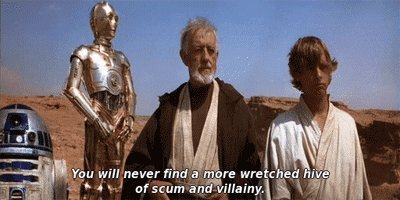
What if I told you that this quote from the original Star Wars film about a town's spaceport could be applied to the internet today? That's definitely a bit dramatic, but this week's readings took a look at the "uncivilized" side of the internet. With the internet's structure and having things in place such as anonymity, personalization and privacy, it's easy to see why people would be more willing to say things over a network that they would likely not say in person. The article by Sude & Dvir-Gvirsman that studied different platforms was a fun one to read on that front. It made me chuckle a bit to see what primary users of different social media platforms thought about their own "civil" level compared to other platforms. Particularly, TikTok users perception that they themselves are uncivil made me laugh because I'd probably agree with their findings.
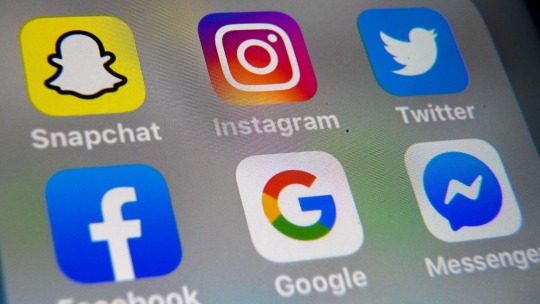
One study that I really enjoyed reading about was the dark participation study by Miller & Nelson. In it, I learned that angry replies to journalists and sources of information had a scholar term, "dark participation." Dark participation is social media at its worst: a negative uprising of replies to attack someone for the information they shared. Journalists are often a big subject of this, receiving hate comments and replies from "trolls" and those that disagree with their findings. Dark participation isn't defined by criticizing if something is right or wrong, but instead just replying in a hostile manner. The article noted that journalist that were women and/or people of color often faced dark participation more than their male and white counterparts. Miller & Nelson interviewed news workers to see what they think can be done to combat dark participation. Respondents noted that a big change from up top needs to be done. Some felt there was a disconnect due to higher ups being mainly older white men that don't understand what dark participation is doing to their workers or that there's a disconnect entirely due. I think that "representation" is often thrown out as an easy answer to stuff like this, but I do agree with that. Respondents in the article specifically touched on the whole "Black Lives Matter" debate and how some journalists of color could not say the statement or show support for it because it would show "bias" and journalist need to stay "unbiased." I understand the desire for unbiased news, but the statement "Black Lives Matter" should not be considered a form of bias or a political statement. I do think people in power in these newsrooms need to change at certain outlets, but I do also think that "bias" should be reevaluated due to the digital age. I don't think it's possible to live a normal life anymore and not have "bias" in the way it has traditionally been defined. I do think you can avoid political bias in your work, but the BLM discourse showed that we definitely need to evaluate what exactly is considered bias in this day and age.
0 notes
Text
Imagery: the internet's most powerful tool.
An interesting thing to look at with the increase of internet usage in society is the change in relation to how people view images. One reading from this week, Paige Brown Jarreau and her team's "Using selfies to challenge public stereotypes of scientists" looks into how image usage could alter people's pre-determined beliefs. Specifically, the study looked into scientists/members of science fields and how taking selfies altered how people viewed them. Members of the science field are sometimes looked at negatively compared to other fields. My personal thought is that there's a mix of reason for why people think that. Workers in science are often viewed as incredibly intelligent, much more so than an average person, and this could be considered intimidating. Another reason that Jarreau states in the article is that science fields members have not embraced the rise of public engagement and new media tools like other fields have. The study, which showed different images of scientists and their work, found that scientists who posted selfies (#ScientistsWhoSelfie) had a much warmer reception for participants compared to non-selfie images. Additionally, selfies did not present those in the image as "less-knowledgeable" and the study also showed a positive effect for gender comparison. What I think is important to take from this study is that how you present an image can be beneficial to a brand. In the study's case, selfies countered the stereotypes that scientists weren't approachable. A non-experiment example of how this approach works today is famous figures using social media.

Specifically, in the midterm elections last year, one election I followed closely was John Fetterman vs. Mehmet Oz in Pennsylvania. Where Fetterman won the tight race was in votes from younger voters and one way he won this age group was his work on his social media channels. Fetterman received national credit for having a social media image that was seen as "authentic" and "true to himself." Fetterman's use of imagery to make himself seem more relatable, despite being a politician, worked well and it lines up with the ideas that Jarreau and her team pitched as a result of their studies.

The other reading was a piece by Stefania Vicari and Daniel Kirby, "Digital platforms as socio-cultural artifacts: developing digital
methods for cultural research." It brings a valid point that social media research has a lot of different variables in it compared to other research fields. Digital methods are different compared to traditional methods and perhaps because these methods are younger by comparison, they're not as efficient or "full picture." Vicari and Kirby believe they found the way to centralize digital methods a little more and embrace the "quali" side more, which they believe is typically neglected for the "quanti side." In all honesty, this reading left me with more questions than answers, especially with the way they showed "cross-cultural research" with their work on food consumption in Brazil and South Africa. I don't think their road map can be that general approach they want it to be just because digital methods for research are all so different. Of course, it is possible that I missed the authors' point in this reading entirely. I just think that there's too many different factors with research in digital platforms that trying to create methods like they did feels like a waste.
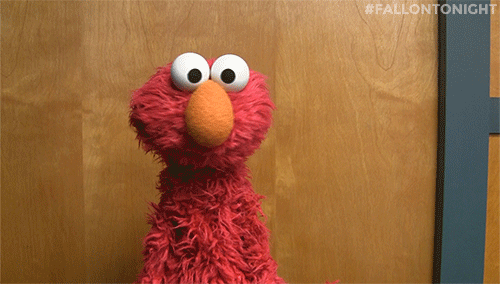
0 notes
Text
While internet communities do change with the times, some things stay the same.
A common thing that's associated with the rise of the internet is the ability to connect with people in just a few clicks or taps of a screen. For example, you could find likeminded people that enjoy the same hobbies that maybe your coworkers or friends don't necessarily do and become acquainted over that. This week's readings were interesting to look at because they discussed community over the internet, but the examples given in the readings were different from each. It's important to know that while apps like TikTok and Instagram thrive on creation of "personable" content, there is still a demand for websites such as Reddit that resembles more of an anonymous community that work differently compared to an app like TikTok.

I've always been curious about Reddit as a source of research. I've casually used the website since I was a high schooler to keep up with various subreddits such as r/Soccer, a community that post news and highlights of popular soccer matches or another subreddit like r/FIFA, which is dedicated to news and video clips about the FIFA video game line. While you don't need an account to browse Reddit, many people make an account to either interact with posts they see or essentially create a feed that's only pulls posts from subreddits they choose to follow. Nicholas Proferes and his team discuss the use of Reddit in research, but the obstacles they face were what I expected as someone that uses the website and has learned a thing or two during graduate school. Pseudonymous participation and the inability to pull demographic data due to that is a big obstacle. Additionally, the pseudonymous role could also affect how users interact on the website compared to a platform like Twitter or Instagram where an account is likely to have identification in the form of a media. Reddit is definitely an interesting website to monitor, but I believe its ability to be used in research requires a lot of additional work that most researchers are probably better off putting the effort into elsewhere.
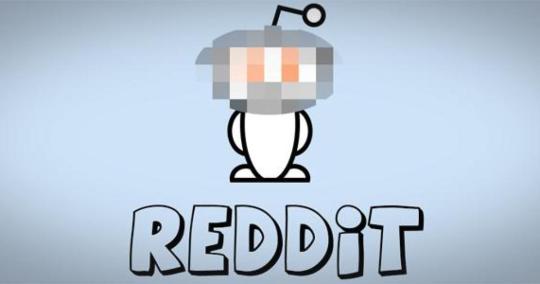
On the opposite tone of that, TikTok has risen to popularity embracing the opposite approach that Reddit has: empowering the users through self-representation. Aparajita Bhandari and Sara Bimo do well to explain the background of the app as well as explaining the algorithm and how it's had success mixing what other apps do and adding its own touch to it. I thought this piece was written well, but I'm curious how it holds up in a few years since TikTok is still a relatively young social media platform compared to its competitors. I'm also curious about how we'll look back at TikTok influencing other apps and changing the general approach for social media. It's already joked about that Instagram's reels feature is essentially based off TikTok model. When LSU Athletics met with representatives from Meta a few months ago, they said that reels were what they were recommending to focus on to get more views and interactions. This, in my opinion, was likely influenced by the current domination of TikTok.
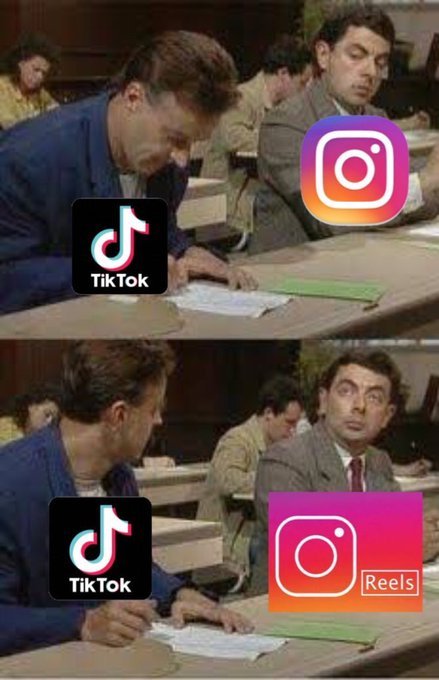
The final reading touched on influencers and how they grow on the internet. The article essentially explains that influencers gain "celebrity capital" on the internet and that social media has a connected "ecosystem" that extends beyond just one platform. I don't think anything in this article was revolutionary or anything, but it was unique in the way of creating a "economic model" for fame and popularity on the internet. I'd be interested in seeing a future article that follows this one up that looks to use qualitative research on the celebrity capital that internet influencers are using (knowingly or unknowingly)!
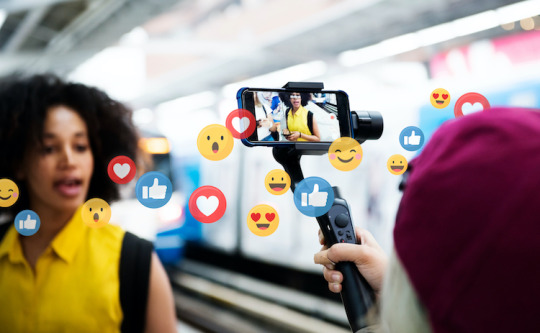
1 note
·
View note
Text
Authenticity: Is that what we really want?
This week's reading focused on a big issue that has been exposed in recent years: authenticity on social media. With social media, we are now able to see more people and locations that we would never be able to see in person with our own eyes. Terms, such as influencers, describe how people post on social media and share bits of their life with their followers. The ability to get a glimpse on social media at stuff that we'd never see otherwise is a good thing, but it can also be a bad thing. As this week's readings covered, "authenticity" of posts are now challenged and there's research on stuff such as the creation of unrealistic expectations both physically and mentally.
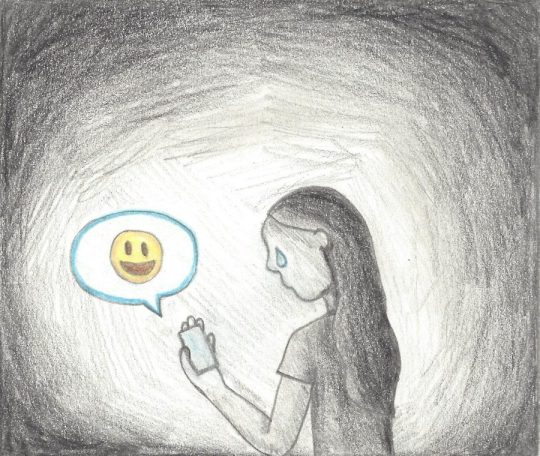
Jordan Foster covered in his article "It's All About the Looks" that influencers have risen on social media, but there's now a call for more diversity in influencer groups. In his research, Foster noted that certain influencers are beginning to adjust to this new "embrace" and are appearing as more authentic visually in their posts now compared to when they first started. Foster's research focused on Instagram fashion influencers and I thought it paired well with Rebecca Kreling and her team's findings in Feeling Authentic on Social Media: Subjective Authenticity Across Instagram Stories and Posts. Kreling and her team found that between posting on a timeline on Instagram and posting on the story feature, participants found that stories felt slightly more "authentic" than normal posts from people. It left me with the question of why I agreed with the research. Is it because posts have room for public responses in the comments or that they're permanently on a page unless deleted? In my own habits, I'll post something on my story that I feel is more authentic than something I'd post on my timeline. After reading these two articles, I'd have to say I probably think that "aesthetic" plays a bigger part in that than I thought.

The final main subject for this week touched on body image on social media. Many people (myself included) have a bad habit of comparing one's self to another person, where you compared your image to theirs, your skill to theirs, etc. While I said earlier it's a good thing social media lets us look at places and people that we'd never see otherwise, it can also be a negative thing. In particular, one big movement I've noticed in recent years has been a push for more body positivity on social media and in ad campaigns. Marika Tiggemann and team discussed this in "Social media is not real: The effect of ‘Instagram vs reality’ images on women’s social comparison and body image" and found that in the "Instagram vs. reality" battle going on today. The findings found that the participants preferred seeing "authentic" images of people and that their body dissatisfaction went down (as well as the reverse). I thought this was an interesting article to pair alongside Kaitlyn Burnell and team's "Snapchat lenses and body image concerns," which found that using Snapchat lenses to alter a photo taken was associated with greater body image concerns. I can't help but wonder how Snapchat in general has probably altered a lot of perception of body image compared to other apps. On Snapchat, you take a picture of yourself until you find it satisfying enough to send to someone or post on your story for friends to see. After doing this many times, whether using a filter or taking a pic multiple times until it sends, you can't help but wonder how much your mind is altered that only certain angles or pictures of yourself are acceptable to present.

0 notes
Text
Social Media: Problematic or Enabling?
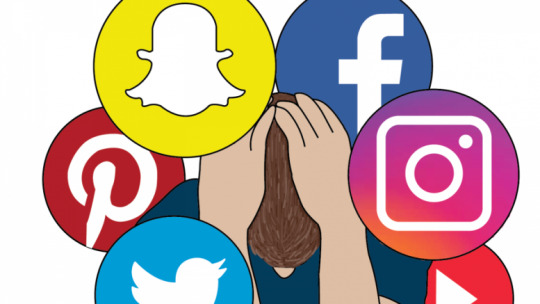
As social media continues to rise and become a norm in our lives, a stigma has risen around it. The idea is that social media has added a new layer into society’s mental health. Being able to connect with people, both local and on a larger scale, on social media platforms is a great thing. There’s also negatives associated with this, such as the idea of adding a work load and having to create a separate social media persona. Our readings this week looked at research involving social media and mental health, a topic that is important to understand to not be wrongly informed.
Sarah Coyne and her team’s research in Does time spent using social media impact mental health?: An eight year longitudinal study is a good starting point this week. The eight year study began in 2009 and ran till 2017 and looked at the use of social media and the mental health levels of the participants. The results showed that the authors could not find associations of time spent on social media and mental health levels of the participants. This reading paired well with Dong Liu and his team’s Digital Communication Media Use and Psychological Well-Being: A Meta-Analysis, which showed that phone calls and texts actually correlated with well-being. Interestingly enough, the article also talked about online gaming being negatively associated with well-being. This made me laugh a little bit as someone who has played video games online with friends and in general as I understand that part. Online video games can be a competitive thing for many people, especially depending on the video game being played. There’s lots of viral videos of people getting angry while playing video games online, so the fact online gaming has a negative association with well-being seems warranted in my opinion.

Habits are a big reason people associate social media as a bad thing and the remaining two readers tackle that issue. Sara Matsuzaka and team studied Black Women’s Social Media Use Integration and Social Media Addiction and found that there was positive correlation between proper social media integration and social media addiction. In simple terms, the study found that women who were vocal on the social media platform and used its features well were identified to have higher levels of social media addiction. This reading is good to pair with Cheng Chen and co.’s Differentiating Problematic from Habitual Instagram Use: A Uses and Grats 2.0 Perspective, which looked at what habits on Instagram crossed into a line of problematic use according to users. The findings showed that the problems on Instagram are not casual lurking, but by the idea that posting on Instagram requires putting on a façade.

So after all this reading, I wondered why people had a perspective on social media being bad for mental health. I agreed with the findings from the readings this week, which when all together showed that social media use and mental health decrease can’t necessarily be connected. I always thought that social media is a great tool and connects people in ways we could not before. I believe the discourse with mental health is a bigger issue that social media simply has the ability to amplify and talk about more with its reach. If anything, the mental health issues have always been there for people, but there was a negative stigma around talking about that for a long time in society. With social media, people communicate important stuff more, such as Matsuzaka and team’s study on black women using social media to talk about black issues they face in life.
0 notes
Text
Thought Paper #10
Sherry Turkle’s Reclaiming Conversation: The Power of Talk in a Digital Age is quite possibly my favorite book that I have read in graduate school. The author tackled a subject that seems to plague everyone, from communications scholars to my next door neighbor. In major, seemingly insurmountable ways, technology, smartphones particularly, is dramatically changing the way that the citizens of the world communicate with each other. Turkle’s solution? Conversation. In every aspect of our lives, we have the power to take control of what is happening to our communicative efforts and create a future that does not seem so bleak.
The funny thing is that this the drama of this subject matter is something we have all heard before. I would argue that for most of my generation, and for some that came before us, these large-scale fears were associated with television. We were going to melt our brains and become ridiculously obese due to inactivity. As a result, there was a constant call to action for everyone to help combat the “dangers of television.” Programs, such as NFL Play 60 and Let’s Move!, were designed to force kids off of the couch and out into the world. Educational programming was the central mission to some channels that provided after-school entertainment. In this way, there was, and still is, an extreme push to create a balance between TV time and everything else.

When we talk about smartphones and the Internet, however, the conversation always heads in a different direction. We note that everyone is so “addicted” to their devices, and fear the day when technology has suddenly disappeared. But is this a realistic fear for the future? Rather than wondering what we will do without technology, we should spend our time figuring out what to do with technology. Finding a balance between life and technology is undoubtedly difficult, so Turkle offers the solution that “conversation cures.” As we develop as children and into adulthood, engaging with one another is just as important as being alone. By working together, we can ultimately work toward solutions that work for everyone.
Just as before with television, we cannot sit idly by and just expect things to get better. Since the major effects of our technology-filled lives take a long time to develop, however, it is often easy to get complacent. I think that there is also a regular tendency to adopt the solutionist view and provide quick fixes that appear to address the big problem, but end up only distracting us from it. For these reasons, we must admit that we need to be proactive. As Turkle discussed, the responsibility rests in everyone’s hands. Parents must set the tone for their children by putting their phones down and engaging in regular conversation with their kids. Teachers must strive to create environments that allow students to benefit from all that technology has to offer, while learning, free of distractions. We must each, individually, adopt this call to action as our own and work to find our own life and technology balance. In doing so, Turkle hoped that we would again have time for face-to-face conversation and that we would not fear it, as many often do. If our communicative practices can change so dramatically, seemingly without our notice, then taking an active role should lead us to incredible solutions.
0 notes
Text
Thought Paper #9
In the modern age, privacy is a concept that is seemingly paramount to our daily lives, but oddly neglected at the same time. It is commonly assumed that social media users, teens especially, are sharing more than ever before about their personal lives (boyd, 2013). Still scholars argue that the information and identities found online are mere performances created by each user to show the world only what he or she wants to be known about them. The truth is that there now exists some level of balance, particularly in the digital space, between privacy and publicity (Jurgenson & Rey, 2013).
As we have discussed in previous class meetings, people often feel that they should be concerned about privacy and the level of knowledge that any given person or corporation has about them. In reality, though, no one seems to actually care. We have better things to do than to be concerned about our “personal” data being collected and sold to the highest bidder. At the end of the day, the complicated algorithms use this information to serve up more content that we actually want to see, resulting in a seemingly-positive, streamlined online experience.
So if we are already participating in the breach of our own privacy, why not take it one step further? Active participation in the sharing of information could potentially remove the creep factor from the digital tracking and surveillance that occurs. Through ideas, such as coveillance, we can move to a way of life in which boundaries are set where privacy is truly needed (Kelly, 2014). Coveillance makes room for actual regulation of this monitoring as well as transparency in its execution. This kind of participation would be essential to easing the minds of those that still find themselves hyper-concerned with the lack of privacy on the Internet.
Another means of active participation is called sousveillance, which involves the masses “watching” those with power, such as the police (Banks, 2011). Through sousveillance, cell phones and similar technology put the power in the hands of the people that aim to provide new perspectives and supposedly-reliable documentation of events. If we were to rely strictly on sousveillance, though, there would likely be a danger of potentially tampering or conflicting interests. For now, the combination of this concept and traditional methods of surveillance can provide important evidence when corroborating a story.
danah boyd (2013) suggested the “eyes on the digital street” idea, where concerned citizens attempt to monitor and offer help to teens reaching out through social media. Too often, teens are ignored or punished by people who are “just trying to help.” Instead, there needs to be some level of balance between the extremes. The problem, therein, is leveraging the available technology to facilitate that balance. A solution may take more time than we would like, but could potentially be found in some combination of all of these elements. We are still at the beginning of a very interesting digital future, and we have a long way to go before we can officially declare it a dangerous, overly public space.
0 notes
Text
Thought Paper #8
In this class and others, we have discussed the varying ways that technology has made important changes and improvements to the way that humans live their everyday lives. Intuitively, it seems that there is much to celebrate regarding the strides that technology has made regarding our societal and individual efficiency. In To Save Everything, Click Here, Evgeny Morozov (2013) posed a more critical view of the way that technology has been “‘inserted’ into our every mundane act, from throwing away our trash to making tea.” I think, for a number of reasons, that he does have a valid point.
First, he labeled this current technological trend to improve as “solutionism.” The central idea is that many of the “problems” that have been identified over the years as in need of solving are not actually problems at all. More importantly, Morozov poses the argument that the composition of these problems is every bit as important as the means used to solve them. This brings an important question to light. Is technology and all of the advances made actually fixing anything of value?
Morozov did not deny the significance of the major problems posing threats to our everyday lives or environments at large. Rather, the legitimacy of the solutions should be questioned. Solutionism offers a distinct environment filled with “quick fixes” to big problems. I would argue that many of the technological advancements that currently exist have actually been “shiny objects” created to distract us from finding real solutions to the problems. For example, we are presented with the problem of a shrinking water supply. Then, we are told that using a new type of faucet will reduce the amount of water that we waste. For its advertised purpose, the problem is solved. But what ramifications do these type of mindless adoptions have?
We live in a world where efficiency is key to every technological innovation. The adopted products are the ones that take the supposed “hard part” out of our everyday activities. One issue with this idea is that, as with Morozov’s example of situational crime prevention, not every problem can be solved with technology. Another problem with this view is that the majority of these solutions are only applicable to that one issue and are not realistically scalable. Morozov discussed the idea that these technological additions to our lives are removing our ability to think critically about the larger-scale problems that we are facing. In a world where we are hardly aware of our energy consumption, the products available aim to make technology all but invisible and to simply allow us to think less and less about the “good” that any product does. In short, we become more dependent on technology to do everything for us without even realizing how intertwined it is with our lives. “It’s important,” he said, “to have eager citizens who are capable of reflecting on how that reform ought to proceed and what values should matter in the process.”
Finally, Morozov said that this focus on the technological optimization of our daily routines can have a moral impact, because temptation and choice have been virtually eliminated. It is not particularly ideal to exist in an environment where citizens behaving in the desired manner, e.g. eating healthy food or reducing waste, is the only thing that matters. The accomplishment of a goal is not enough. Equally important are the means used to do so. The solution, therein, lies with the designers and engineers to find solutions that continue the problem-solving conversations and ensure that humans still have mastery over all of their actions. If, as Ken Alder argued, engineers are truly to construct a better future from the raw materials of the present, human dignity and authenticity have to an equal part of play on the stage of problem-solving.
0 notes
Text
Thought Paper #7
This week’s readings make it painfully clear that, beyond the general troubles they have had with the Internet, scholars and professionals alike are finding it difficult to figure out how to take advantage of the modern practice of news acquisition through mobile devices. In short, journalists have traditionally had a good bit of space on which to reports the events of the day. When advertisers began to encroach and, ultimately, demanded a large portion of this space, reporters had to adapt. When print media started to fall victim to the online realm, journalists had to find a way to make the change, then, too. With every new development, the industry has found a way to adequately adjust. So why is this mobile device issue looming?
As Fernanda Braune of the News Literacy 2016 project noted in her piece, “News Consumption Makes Move to Mobile,” “A web page at least resembled the page of a magazine. Mobile is a deeper and more disruptive shift” (2016). It is no longer a simple copy and paste command for publishing stories online. Instead, we have settled into a world where news content has to be so much more. Demand for news is greater. The expectations of news are higher. But does this necessarily have to be a bad thing?
In my view, no, it does not. This change simply marks an important shift in the way that the public interacts with news. Instead of reading the summary of an exciting event in tomorrow’s paper, we have the unique capability to witness it unfolding in real time. This shift in media consumption may take time for practitioners to figure out, but the ramifications are, notably, positive. As Bob Franklin wrote in “The Future of Journalism,” the switch to mobile devices makes the concept of “news on the move” a reality (2014).
Additionally, people like Yifeng Jiang, also of the News Literacy 2016 project, argue that open journalism, where users contribute to reporting at every stage, is quickly becoming a foreseeable benefit (“Users can help journalists do a better job,” 2016). This idea comes in many forms, such as crowdsourcing, user-generated content, participatory journalism and citizen journalism, but the basic idea is the same. With this concept, users and journalists are working together and contributing to the online news environment. The audience, then, has an active role in the spread of information. This, too, is an important route for future scholars and professionals to further explore.
So why is the the world of mobile phones so frightening? I assume that, as with most forms of change, there is a hesitancy to commit until a real trend is formed. Professionals might feel cautious to jump onto the mobile bandwagon if they feel that the changes are happening too quickly. As technology becomes further intertwined with our lifestyles and daily activities, however, I think it is all too important for every industry to find a way to exist in the space. Humans have this insatiable desire for information and we are willing to consume it in a variety of forms. For journalists, a central purpose has always been to provide citizens with the information that they want and need. Making the switch to mobile will still accomplish that. It will just require a bit more effort than some might like.
0 notes
Text
Thought Paper #6
As digital inequalities continuously widen the gap of the digital divide between those with Internet access and those without, it becomes increasingly essential to find ways to close that gap (Robinson et al., 2015). This is, perhaps, most concerning as our daily lives become further intertwined with technology, e.g. Wi-Fi-enabled automobiles and wearable technology. Those with access build up a greater dependence on the digital space. Meanwhile, those without access are kept further in the dark. With this upsetting idea in mind, there is one solution that is not often discussed.
As technology has evolved, the cost associated with producing it and our expectations of using it have changed, as well. Computers used to cover the expanse of an entire room. Now, they can be carried in our pockets. Most of our everyday essentials have followed the same pattern, because consumers have consistently demanded simplicity and efficiency. Naturally, there are some marketplace items that always have an expensive, luxury cost, e.g. jewelry and sports cars. The Internet, however, is not some type of rare gem or carefully manufactured vehicle. Although the gap continues to widen, users have constantly made the Internet a mainstream product (Eastin, Cicchirillo, & Mabry, 2015). Gone are the days of having to sit down at the “family computer” and start the dial-up modem to look research a topic. We can, now, pull out our phones and do a quick Google search in less time than it would have taken to turn on the computer.
Like most commodities, the cost of Internet access has fluctuated over time. We used to pay upwards of $200 for a flip phone, when we can now spend that same amount on an entry-level smart phone. While the latest and greatest forms of technology initially get matched with a top-dollar price tag, the cost of the items that came before it shoots down dramatically. Many of the price-savvy consumers in any market will often wait for the newest model to launch in order to buy the previous version. In this way, there is a sort of “trickle down” effect on the affordability of any technology. With this idea in mind, maybe there is a chance that the cost of Internet access and associated digital tools, could trickle down to everyone, too.
The major issue standing in the way of this idea, however, is the almost ephemeral nature of our current technology. As we discussed last week, we are all caught in a continuous and frustrating cycle, where we are forced to buy the newest versions of our technology. Unlike the Nokia phones of the past, smartphones are just not built to last forever. With that in mind, it is near impossible for for the trickle down effect to occur. If the products cannot last long enough to reach the hands of those that cannot initially afford them, the previously mentioned gap will only continue to widen. While it is, ultimately, unclear how the future will affect the digital divide, the solution may potentially lie in a change of this cyclical endeavor. The Internet does not have to be an exclusive tool for the few, but it will be tremendously difficult to bring access to everyone. If we are truly to have Internet access for all, technology producers would have to bring us products that could last forever, while, simultaneously, being new and exciting.
0 notes
Text
Thought Paper #5
Astra Taylor discussed the idea that Web 2.0 has created an experience, which was given the label “digital feudalism.” In such an environment, we comprise “armies of digital peasants” vying for pieces of digital space that sits in the hands of those in control, e.g. Facebook and Tumblr. This notion ties into the previously discussed ideas of digital democracy being a myth. The openness of the Internet has allowed anyone with access to contribute to the online conversation, but scholars hold that it is not so easy for everyone’s voices to be heard in the same space. She noted that older, white males tend to achieve the most success on the Internet, even though the population of the digital world spans a wholly diverse community.
With the number of contributions to the Internet increasing rapidly every day, it is easy to understand why this “digital divide” continues to widen its gap. A concern, however, is raised when we consider the ways that those with control over our digital media can govern what content achieves success. Last week, we discussed the idea that Facebook forces any “page” to pay advertising fees to appear on its followers news feeds. We also talked about YouTube’s partnership program, where users can gain some of the ad revenue for ads placed on their videos. These activities are a major concern because, while it is great that these platforms want to assist their users in finding a greater online presence and voice, it comes at a cost to the users. Gone are the days of easy, cheap and efficient use of social media for potential gain. Now, if you want to be heard on the Internet, you have to invest time and, often, money to do so.
Taylor also considered Sarah Lacy’s point that we are all addicted to social media and the “validations and human connections” that are achieved through use of these platforms. This point raises another concern. Are we all so addicted to social media that we cannot possibly separate our lives from it? Surely there are exceptions to this sort of addiction. However, the major changes that social media has brought to our society could suggest that the power of the digital space may be too intertwined with the real world to be separated.
Taylor, then, discussed the idea that the immediacy of information is, for some, diminishing the importance of quality information. Considering how short human’s attention spans have become in recent years, this notion is not overly surprising. I feel, however, that there is still a large need for quality information in a variety of forms. For example, a high school student can read the synopsis of a book online or watch the film interpretation, but he or she will never gain the full experience brought about by reading the novel. In order to get the “whole picture” or gain the ultimate understanding of the world around us, we have to be willing to consume more than just the superficial information that we find while scrolling through Facebook on a coffee break. If the Internet can continue to provide a space for quality, I believe that consumers will still seek it out.
0 notes
Text
Thought Paper #4
Van Dijck (2013) detailed the ways that social media has evolved over time with its users and that we are now part of a culture of connectivity. Today’s various platforms have adapted to and have been created for their users’ needs. Thus, social media is akin to the varying forms of legacy media, which have also changed to fit the public that they serve. In the way that journalists will give the public the stories that they most desire, creators of social media platforms have strived to deliver whatever it is that their users want. This relationship is, ultimately, beneficial for the creators, as well, because they gather, analyze and, sometimes, sell the data collected about their users. The social media landscape is, thus, one comprised of a symbiotic relationship between moderators and users.
Of course, it is the “social” aspect of this media that makes it so distinctive from those that came before it. The two-way communication model facilitates both a unique user experience and an expansion of the traditional social network. Users are able to create their own content, which, in turn, creates a completely new type of information environment. Today, anyone can have a voice and contribute to the online conversation. Additionally, users are able to connect to each other through online networks. Our boyd readings have shown that the motivations behind this interaction differ across age groups. Older users are generally utilizing these online services to network with other people, thus, expanding their social circles. Meanwhile, the youth are simply there to “hang out” with their friends and maintain their pre-existing social network.
This newer media goes one step further as it often affects users’ attitudes and actions. Social norms are regularly reflected in the online sphere and, often, altered through the gradual changes of users’ online habits. All of this culminates in what Van Dijck called an “ecosystem of connective media,” which both nourishes and is nourished by the growth of the world outside. As the social media develops, so, too, does the reality of its users. Since social media is still so new, it will be interesting to see what new norms are created in the near future and how online activity shapes reality over time.
Naturally, there are downsides to the ever-growing nature of social media. Users are subject to a more commercial environment; just as legacy media have become overrun with advertisements in various forms. The interesting thing about social media is that it has demanded commercial entities to be more and more creative in order to reach consumers on the web. As each new platform surfaces, there is a short period of time where the media is free of corporate interaction. Over time, however, businesses manage to find a way through. In some ways, this is an exciting time for advertisers. Not only are these professionals forced to find new ways to reach consumers, but they must do so even more quickly than before. Consumers have shorter attention spans and the popularity of each platform is consistently shifting. The environment of social media is extremely competitive and fast-paced; advertisers have to keep up if they want to succeed.
0 notes